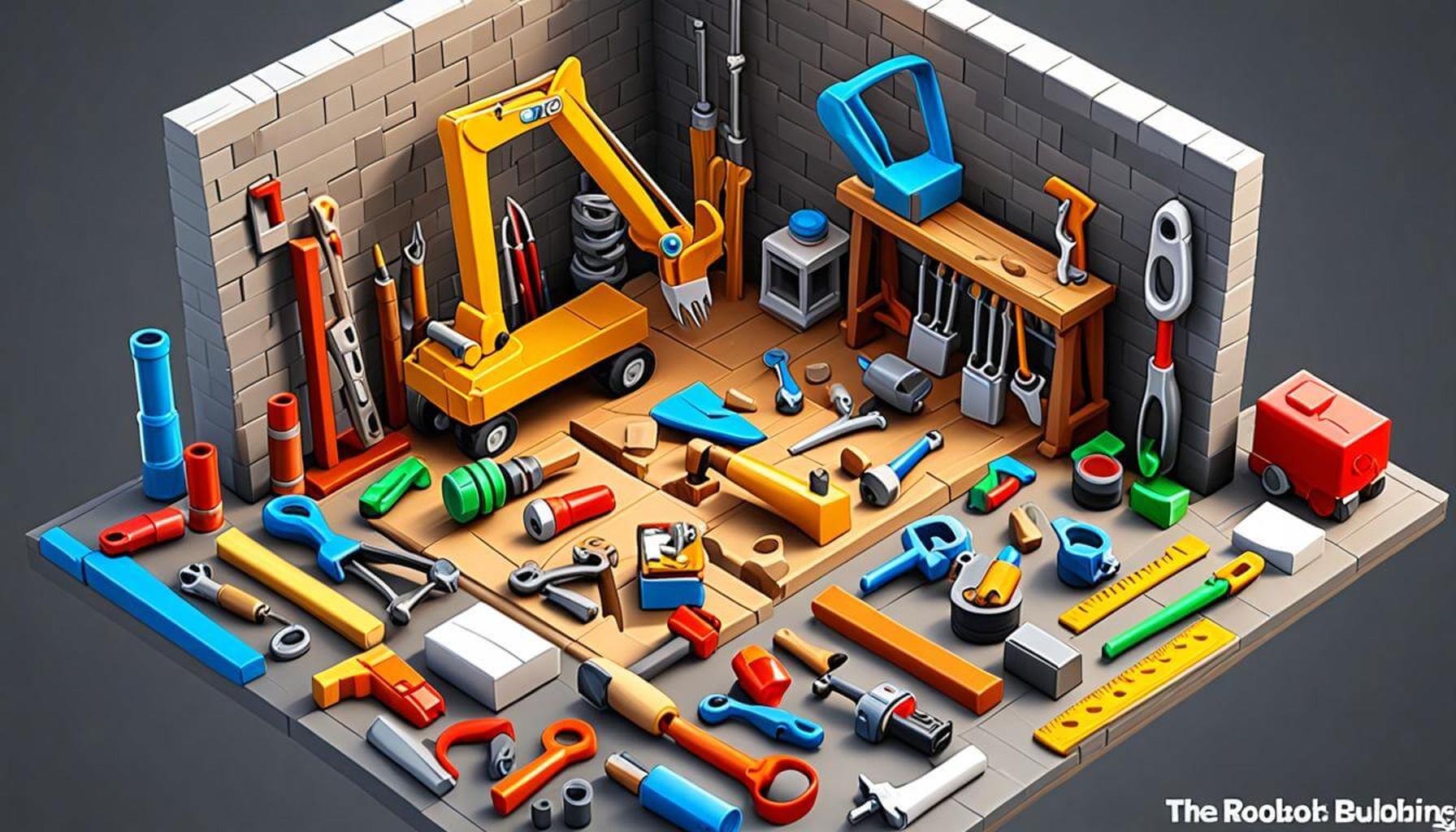The Evolution of Creative Building Tools in Roblox: From Basic to Advanced

Anúncios
Transformation of Roblox and its Creative Tools
The evolution of Roblox is a fascinating journey that mirrors the broader trends in technology and digital creativity. Initially launched in 2006, Roblox started as a simple gaming platform where users could interact with basic block-like environments. Over the years, it has morphed into a vibrant universe that fosters interactive experiences and complex game designs, engaging millions of players and developers alike.
Anúncios
The early days of Roblox featured basic building tools, which were primarily designed for novice users. These tools included straightforward blocks and templates that enabled users to create simple games and environments with minimal effort. For instance, a player could arrange blocks to set up a rudimentary obstacle course, which provided an entry point for many aspiring developers. However, the limitations of these tools often left creative individuals yearning for more sophistication.
As the demand for more intricate designs grew, Roblox introduced intermediate features. This phase saw the arrival of advanced shapes and terrain manipulation options, paired with scripting capabilities using the Lua programming language. Such features opened the door for creators to build dynamic experiences, like role-playing games and intricate obstacle courses, which required more complexity in design and logic. A prime example during this time would be the creation of interactive games like “Adopt Me!”, a massive hit that relies on users’ ability to manipulate in-game elements using scripting.
Anúncios
Today, users can harness advanced building tools that elevate their creative potential even further. The introduction of a comprehensive suite of features, including model import/export options and real-time collaborative editing, has transformed how developers work together. For example, teams can simultaneously work on the same project from different locations, thanks to these collaborative tools. As a result, creators can experiment with ideas and refine their designs in real time, making the development process more fluid and dynamic.
This evolution of creative building tools in Roblox highlights a significant trend: the platform is not just about playing games but also about building community. It encourages teamwork and fosters a diverse environment where users can showcase their skills. This collaborative spirit is evident in the many game development groups and competitions that exist within the platform, where creators from various backgrounds come together to innovate and inspire.
As we explore the remarkable growth of these tools, it becomes clear that they have not only shaped the landscape of gaming but also contributed to a cultural shift in how creativity is expressed and shared. Roblox has become a canvas for limitless imagination, giving rise to intricate game experiences that captivate audiences across the United States and beyond.
DIVE DEEPER: Click here to uncover more insights
The Journey from Basic to Intermediate Tools
The early building tools in Roblox laid the foundation for countless creativity-based projects. These initial offerings were simple yet effective, allowing players to grasp the basics of game design without becoming overwhelmed. Users could drag and drop basic shapes to form structures, but they were often limited to pre-existing templates, restricting their creative freedom. As players began to explore the platform, many experienced the frustration of these restrictions when trying to manifest more complex ideas.
Recognizing the need for greater creative freedom, Roblox transitioned into the intermediate phase, which was marked by a significant expansion in its toolset. This pivotal change introduced several new features:
- Advanced Shapes: Customizable shapes allowed users to craft more intricate structures, moving beyond the basic block aesthetic.
- Terrain Manipulation: Users could now sculpt landscapes with hills, valleys, and textures, bringing a new level of realism to their games.
- Scripting with Lua: For many, the introduction of Lua scripting was a game-changer. This programming language empowered users to create complex game logic, allowing for interactive environments and personalized player experiences.
One standout example from this period was the advent of role-playing games (RPGs) on the platform. Titles like “Shindo Life” and “Brookhaven” emerged, showcasing how enhanced tools allowed for unique narratives and player-driven environments. The introduction of scripting enabled creators to incorporate quests, NPCs, and even conversation trees, giving players an immersive experience that echoed traditional RPGs.
The community’s response to these advancements was overwhelmingly positive, igniting a creative renaissance within Roblox. As more users began to leverage these intermediate features, the platform experienced a surge in diverse game genres, spanning from simulation games to escape rooms. The collaborative aspect of this evolution cannot be overstated; users formed teams, pooling their talents to push the boundaries of what was possible within Roblox.
In this dynamic environment, users consistently sought innovative ways to incorporate feedback and iterate on their creations. This led to a continual improvement loop, where ideas evolved rapidly, reinforcing the idea that collaboration is one of the platform’s greatest strengths. As game development groups became more prevalent, platforms like Discord emerged as vital communication tools, enabling real-time updates and brainstorming sessions among developers.
As Roblox continued to grow, the appetite for even advanced features became evident. The community’s enthusiasm was a testament to the power of creative tools that adapt alongside developer needs, ensuring that Roblox would remain a relevant and engaging platform for creative minds of all ages.
| Category | Key Features |
|---|---|
| Basic Building Tools | User-friendly and intuitive, allowing beginners to create simple structures. |
| Advanced Scripting | Powerful capabilities for creating complex interactions and functionalities. |
The landscape of building tools in Roblox has experienced a remarkable transformation from its humble beginnings to the sophisticated options available today. In the early stages, the basic building tools were designed to help newcomers grasp the essentials of game design. These tools provided an accessible entry point, promoting creativity without overwhelming users with complex features. Players could create simple structures that fostered a sense of accomplishment and sparked their imagination.As the Roblox platform evolved, so too did its building tools, leading to the introduction of advanced scripting options. These advanced capabilities, such as Roblox Lua scripting, transformed the way creators approached their projects. With a deeper understanding of scripting, users can implement intricate game mechanics, enhance interactivity, and create unique gaming experiences that captivate players. This powerful evolution invites authors and developers to push their creative boundaries and innovate like never before, showcasing the true potential of Roblox as a platform for imaginative expression.
DIVE DEEPER: Click here to learn more
The Leap to Advanced Building Tools
As the Roblox community continued to grow, the clamor for advanced building tools reached new heights. The platform responded decisively with further enhancements that dramatically transformed the creative landscape for developers. This evolution was not merely about adding features but about redefining the entire gaming and building experience. With the introduction of Roblox Studio, users were equipped with professional-grade capabilities that rivaled the best in the industry.
The most notable advancement was the introduction of the Terrain Editor, which revolutionized landscape design. This powerful tool enabled creators to shape not just static environments but dynamic ones. Users could integrate biomes, weather effects, and massive terrains that could alter gameplay, creating an immersive experience. For instance, games like “Adopt Me!” utilized these advanced terrain features, allowing players to traverse diverse landscapes that enhanced gameplay and engagement.
Corollary to these environmental enhancements was the expansion of the Asset Library, which now hosts millions of user-generated assets. This library enables users to share their creations seamlessly, fostering a culture of collaboration. Developers can access a wealth of ready-made models, scripts, and animations, significantly trimming development time. The collaborative ecosystem of Roblox fueled a new level of creativity, leading to titles featuring sophisticated mechanics and visually stunning worlds.
- Roblox Plugins: These third-party tools offered functionalities that further elevated building capabilities. Developers could customize their workflows, automate tedious tasks, and implement features that were previously unavailable.
- Networking Features: New capabilities in multiplayer game development allowed for synchronized interactions and more profound player connections, facilitating innovative gameplay that ranges from cooperative challenges to competitive arenas.
- Monetization Tools: With the introduction of Microtransactions and Game Passes, developers gained the opportunity to monetize their creations, encouraging more serious game design that could compete in the broader gaming market.
The gamer demographic also began expanding, with more teenagers and young adults entering the platform to hone their skills in game development. This shift necessitated the need for advanced features. Tutorials, forums, and live streams dedicated to facilitating learning on advanced tools proliferated, democratizing knowledge of complex techniques. As a result, many creators were able to leverage sophisticated programming methods to develop intricate game systems that integrate multiplayer dynamics and unique story arcs.
This push for advanced tools also resulted in the rise of educational initiatives within the platform. Programs like Code Kingdoms and various coding bootcamps now utilize Roblox to teach programming and design skills to younger audiences. By using Roblox’s building tools to facilitate learning, educational institutions leveraged the platform’s accessibility and engaging nature. The introduction of these educational programs highlights a commitment to not just entertainment but growth and skill development within the burgeoning game development community.
Roblox has successfully created a vibrant ecosystem that spans casual creators to aspiring developers, and the trajectory of its building tools illustrates a greater narrative about digital creativity. The modernization of these tools has not only fueled individual passion projects but has also positioned Roblox as a training ground for the next generation of game developers, pushing the envelope on what creative building tools can achieve.
DISCOVER MORE: Click here to learn about the power of collaboration in Roblox
Concluding Thoughts on Building Tools in Roblox
The journey of creative building tools within Roblox encapsulates a remarkable evolution that reflects both technological advancements and community demands. From the rudimentary options available at its inception to the sophisticated Roblox Studio and integrated Terrain Editor, these tools have forged a path for aspiring game developers to express their creativity and build immersive experiences. The expansion of the Asset Library and the incorporation of Roblox plugins illustrate a commitment to fostering collaboration and innovation among users. This not only streamlines development but also encourages a culture of sharing that enriches the entire platform.
As Roblox embraced more advanced features, it effectively transformed into not merely a gaming platform but a vital educational resource. With initiatives aimed at teaching programming and game design, the platform is cultivating the next generation of creators who are not just consumers of content but producers as well. The increased access to tutorials and coding boot camps signifies a shift toward an empowered community ready to leverage these tools for intricate game systems and unique narratives.
Ultimately, the evolution of building tools in Roblox is more than just an enhancement of user experience; it is a testament to the dynamic nature of digital creativity and its potential to inspire. As we look to the future, the possibilities for game development on this platform appear limitless, inviting both seasoned developers and novice creators to push the boundaries of what can be achieved within virtual worlds. This ongoing evolution is a clear indicator that Roblox will continue to be a frontrunner in democratizing game creation and nurturing a vibrant, innovative community.
Related posts:
Impact of Creator Communities on Game Development in Roblox
Trends of Artistic Style in Creative Builds on Roblox: A Visual Analysis
Exploring the Evolution of Creative Building Tools in Roblox: Trends and Innovations in 2023
The Importance of Collaboration Between Creators in Roblox for Ambitious Building Projects
How Creative Building in Roblox Is Influencing Game Design on Other Platforms
The Role of Interactive Narrative in Creative Building Experiences in Roblox

James Carter is a financial writer and advisor with expertise in economics, personal finance, and investment strategies. With years of experience helping individuals and businesses make complex financial decisions, James offers practical insight and analysis. His goal is to give readers the knowledge they need to achieve financial success.
